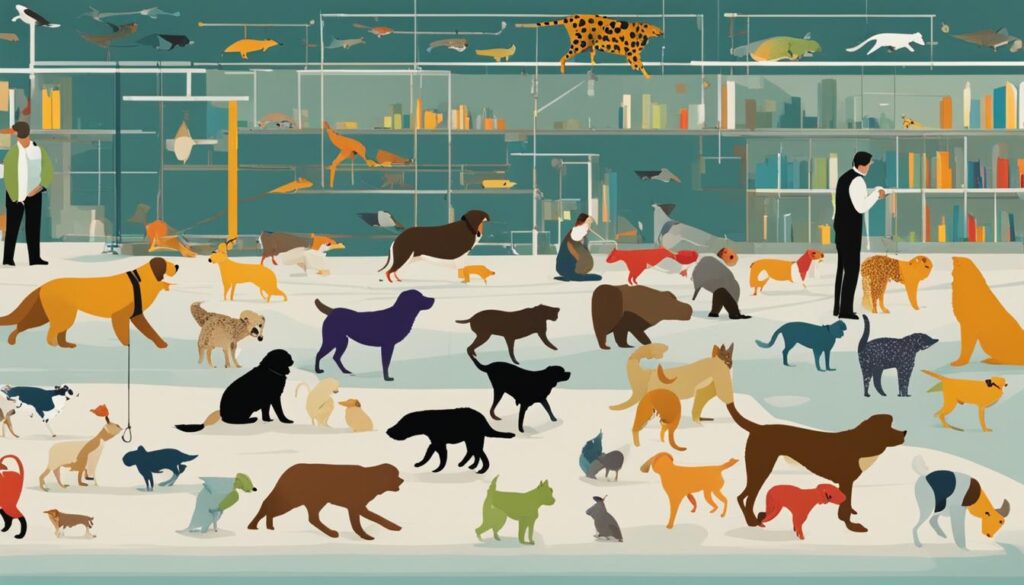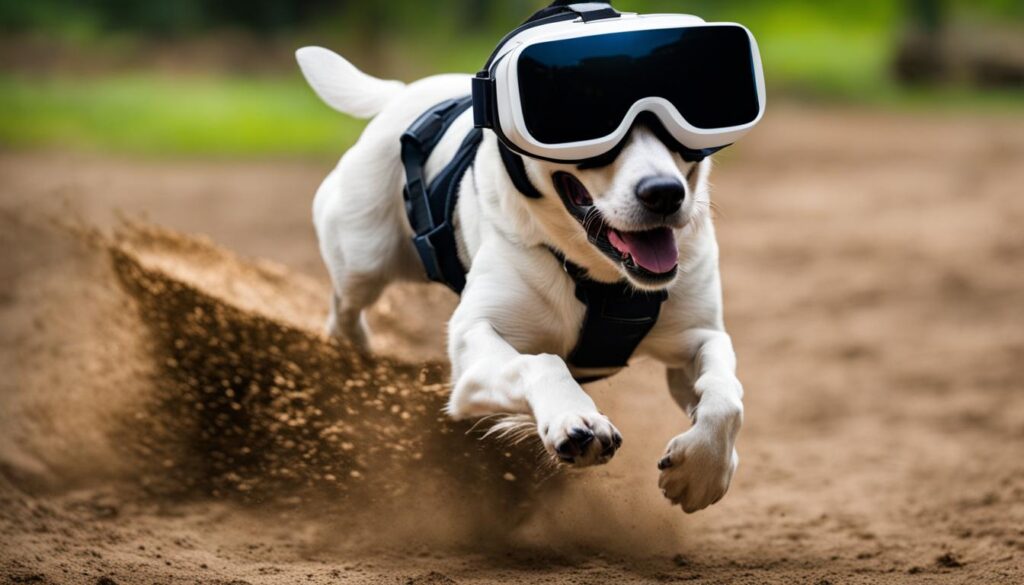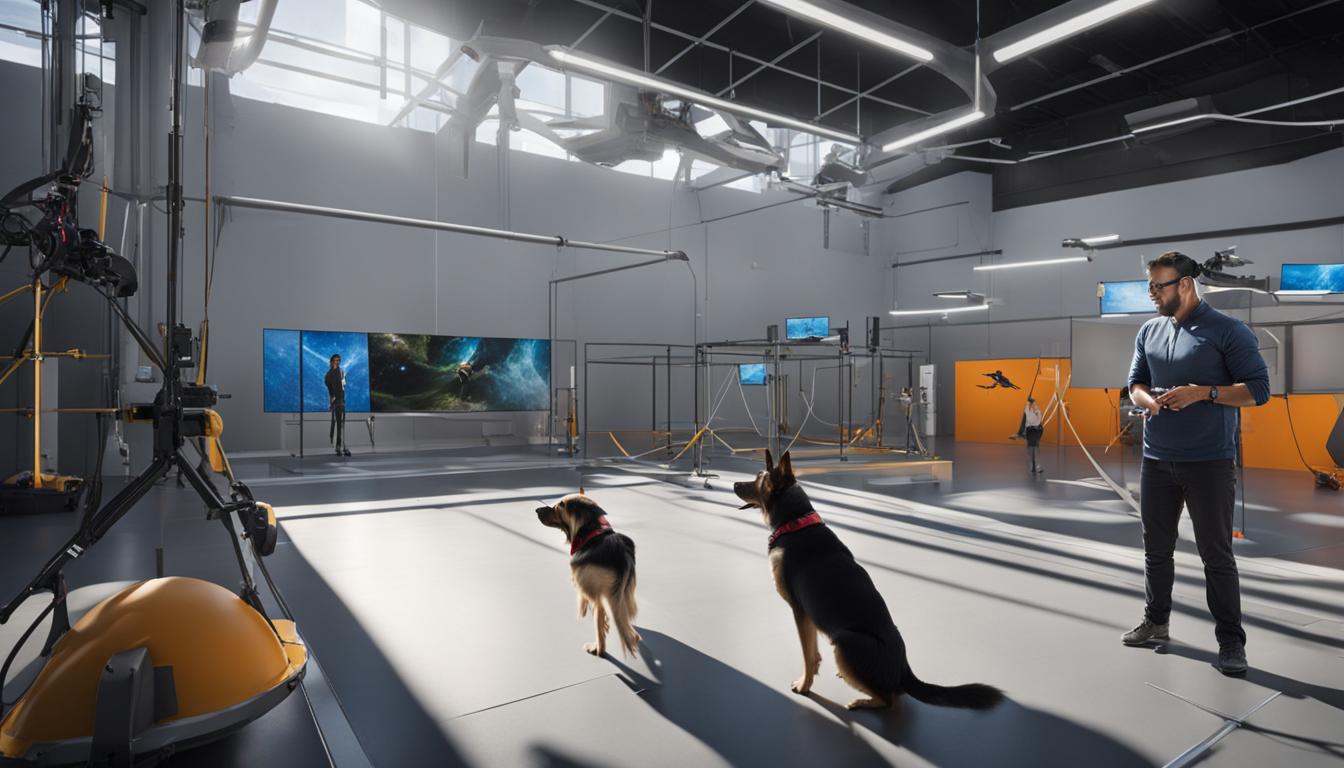Welcome to the fascinating world of dog training! As our understanding of animal behavior evolves and technology advances, so too do the techniques and methods used to train our beloved four-legged friends. In this article, we will delve into the future of dog training, exploring the cutting-edge innovations and emerging research that are shaping the field.
For centuries, dogs have worked alongside humans, fulfilling various roles from shepherding to assistance. In recent times, both the practice of training dogs and the scientific study of animal behavior have made significant strides forward. However, there has been a lack of collaboration between these two fields, hindering the progress of training practices in the 21st century.
Our goal is to bridge this gap by exploring the history of working dog training and examining the scientific advancements in animal behavior that can be applied to training. We will also highlight areas for future collaborative research between researchers and practitioners, paving the way for more effective and humane training techniques.
Key Takeaways:
- Future dog training techniques and research are shaping the way we train our four-legged companions.
- Innovations in canine training methods are focused on positive reinforcement-based approaches.
- The scientific study of animal behavior has paved the way for advancements in training practices.
- Collaboration between researchers and practitioners is crucial for advancing training techniques in the 21st century.
- The global dog training services market is experiencing significant growth, driven by increasing demand and continuous advancements.
The Origins: A Brief History on the Origins of Working Dog Training
Working dogs have a rich history that dates back centuries. These highly skilled canines have played integral roles in various tasks, ranging from hunting to assisting in wars. The formalized training of working dogs, however, didn’t begin until the 20th century when notable training manuals and procedures were developed.
One influential figure in the field of working dog training is Col. Konrad Most, whose manual “Training Dogs: A Manual” published in 1910 has had a significant impact on military and law enforcement dog training. His methods laid the groundwork for the systematic training of dogs, emphasizing the use of positive reinforcement and understanding canine behavior.
Detection dogs, which are trained to identify specific substances or objects, also have a storied history. Their extensive training began during the Vietnam War, where they were used to detect explosives and narcotics. Positive reinforcement and behavior research became the focus of their training, resulting in more reliable and efficient detection capabilities.
In the realm of assistance dogs, such as guide dogs for the visually impaired, training techniques have evolved over time. Since the early 20th century, emphasis has been placed on early socialization and building a strong rapport between dogs and their handlers. This approach has proven to be highly effective in producing well-trained assistance dogs that can navigate complex environments and provide invaluable support to their handlers.

From protection and apprehension dogs to detection and assistance dogs, the history of working dog training is a testament to the dedication and innovation of trainers and handlers worldwide. By understanding and appreciating the origins of working dog training, we gain valuable insights into the evolution of techniques and the ongoing advancements shaping the future of this crucial field.
Changes Across the Twentieth Century in Animal Behavior
The understanding of animal behavior has undergone significant changes throughout the twentieth century. The emergence of animal behavior science, including classical conditioning, operant conditioning, and early behaviorism, has revolutionized our understanding of how animals learn and respond to their environment.
The Rise of Animal Behavior Science
Animal behavior science emerged in the late 19th and early 20th centuries as a response to the need for a systematic approach to studying animal behavior. Researchers like Ivan Pavlov and Edward Thorndike paved the way for classical conditioning and operant conditioning, respectively, which were key theories in understanding animal behavior.
“Classical conditioning is a form of learning in which an animal learns to associate a neutral stimulus with a biologically significant stimulus, resulting in a conditioned response.”
This groundbreaking research laid the foundation for behaviorism, a school of thought that focused on studying behavior rather than internal mental processes. Behaviorism brought a new scientific rigor to the study of animal behavior, emphasizing the observable and measurable aspects of learning.
The Influence of Early Behaviorism
Early behaviorism had a profound impact on animal training practices. By understanding the principles of classical conditioning and operant conditioning, trainers could effectively shape and modify animal behavior. These techniques were particularly influential in areas such as dog training, where positive reinforcement and punishment played a significant role in behavior modification.
Operant conditioning, in particular, became a cornerstone of animal training. It involves reinforcing desired behaviors through rewards and punishments, which led to the development of more effective training techniques. Trainers could now shape behaviors through a systematic approach, focusing on positive reinforcement to encourage desired behaviors and negative punishment to discourage unwanted behaviors.
The Evolution of Animal Behavior and Training Practices
Over the years, our understanding of animal behavior and training practices has continued to evolve. While classical conditioning and operant conditioning remain fundamental principles, modern trainers have embraced a more holistic and positive approach to training. The emphasis is on building a strong relationship between the trainer and the animal, promoting trust and cooperation.
Today, animal behavior science continues to advance, incorporating new technologies and research methodologies. Virtual reality and artificial intelligence are being explored as tools for understanding and modifying animal behavior. The future holds exciting possibilities for further advancements in training practices and the overall well-being of our animal companions.

| Key Concepts | Description |
|---|---|
| Classical Conditioning | A form of learning in which an animal associates a neutral stimulus with a biologically significant stimulus, resulting in a conditioned response. |
| Operant Conditioning | A type of learning that focuses on the consequences of behavior, using rewards and punishments to shape and modify behavior. |
| Early Behaviorism | A school of thought that emphasizes the study of observable behavior rather than internal mental processes. |
| Positive Reinforcement | The use of rewards to reinforce desired behaviors, increasing the likelihood of their recurrence. |
| Negative Punishment | The removal of a desired stimulus to decrease the likelihood of undesired behaviors recurring. |
Exploring Relationships Between Dog Training Approaches and Behavior Outcomes
When it comes to dog training, understanding the relationship between different training approaches and behavior outcomes is crucial. One widely used approach is operant conditioning, which involves reinforcing desired behaviors and discouraging unwanted behaviors through the use of rewards and punishments. But how do these approaches impact behaviors like aggression, fear, and the dog-owner relationship?
In a recent study, researchers sought to answer this question by analyzing the effects of different training approaches on aggression, fear, and the quality of the dog-owner relationship. The study found that frequent use of negative reinforcement, a type of training where an aversive stimulus is removed to increase the likelihood of a behavior occurring again, was associated with higher scores in stranger-directed aggression, owner-directed aggression, dog-directed fear, and attachment/attention seeking. On the other hand, frequent use of negative punishment, where a desirable stimulus is removed to decrease the likelihood of a behavior, was linked to lower levels of familiar and unfamiliar dog-directed aggression.
This study highlights the importance of considering the potential impact of different training approaches on a dog’s behavior. It suggests that a heavy reliance on negative reinforcement may lead to higher levels of aggression and fear, while negative punishment may be more effective in reducing certain forms of aggression. However, it’s important to note that each dog is unique, and what works for one may not work for another. It’s crucial for trainers to take an individualized approach and consider a dog’s temperament, history, and specific training needs.
“The study found that frequent use of negative reinforcement was associated with higher scores in stranger-directed aggression, owner-directed aggression, dog-directed fear, and attachment/attention seeking.”
Building a positive and trusting relationship between a dog and their owner is another important aspect of training. Positive reinforcement-based methods, which focus on rewarding desired behaviors, have been found to be effective in promoting a strong bond and cooperation between dogs and their owners. These methods can help build trust, reduce fear, and foster a positive learning environment for dogs.
| Training Approach | Impact on Behavior |
|---|---|
| Negative Reinforcement | Higher levels of aggression, fear, and attachment/attention seeking |
| Negative Punishment | Lower levels of certain forms of aggression |
| Positive Reinforcement | Promotes trust, cooperation, and a positive dog-owner relationship |
Ultimately, the key to successful dog training lies in understanding the individual dog, using appropriate training techniques, and prioritizing the dog’s well-being and the quality of the dog-owner relationship. As our knowledge of animal behavior and training continues to evolve, it’s important for trainers and owners alike to stay informed about the latest research and advancements in training practices.
Innovations in Dog Training Techniques and Research
The world of dog training is constantly evolving, with new techniques and cutting-edge research shaping the future of canine training. From specialized training programs to advancements in technology, the innovative approaches being developed are revolutionizing the way we train our four-legged friends.
One of the emerging techniques in dog training is the use of positive reinforcement. This method focuses on rewarding desired behaviors rather than punishing unwanted behaviors. By using treats, praise, and play as rewards, trainers can create a positive association and motivate dogs to repeat desired actions. Positive reinforcement not only strengthens the bond between dogs and their handlers but also helps to shape their behavior in a positive and consistent manner.
“Positive reinforcement-based methods in dog training have shown to be highly effective in improving behavior and promoting a strong bond between dogs and their owners,” says Dr. Sarah Thompson, a renowned animal behaviorist.
Advancements in technology have also played a significant role in the evolution of dog training. Virtual reality (VR) is being explored as a tool to simulate real-life scenarios for training purposes. By immersing dogs in virtual environments, trainers can expose them to various stimuli and teach them how to respond appropriately. Additionally, artificial intelligence (AI) is being used to analyze canine behavior patterns and develop personalized training plans for individual dogs.
Research in dog training is continuously pushing the boundaries of what we know about canine behavior. Scientists are studying the cognitive abilities of dogs, their social interactions, and how they learn. This research not only enhances our understanding of dogs but also provides valuable insights into how we can optimize their training experiences.
As we look to the future, it’s exciting to see how these innovations in dog training techniques and research will continue to shape the way we train and interact with our furry companions. By staying at the forefront of these advancements, trainers and dog owners can build stronger relationships with their dogs and create a positive and enriching training environment.

The Market for Dog Training Services
When it comes to the market for dog training services, the future looks bright. In the coming years, this industry is expected to experience significant growth as more and more dog owners recognize the importance of professional training for their furry friends. With a growing demand for trained dogs that can fulfill various roles and tasks, the market is becoming increasingly dynamic and competitive.
Key players in the dog training services market include DoGone Fun, Citizen Canine, Noble Beast Dog Training, PetSmart, and Bark Busters. These companies offer a range of training programs, from beginner to advanced, tailored to meet the unique needs of each dog and owner. As the market continues to evolve, these key players are adopting new strategies to stay ahead of the competition and cater to the changing demands of dog owners.
To better understand the market trends and future growth prospects, let’s take a closer look at some key insights:
Dog Training Market Trends:
- The rising adoption of positive reinforcement-based training methods: Dog owners are increasingly recognizing the benefits of positive reinforcement in shaping desired behaviors and strengthening the bond between them and their dogs.
- The incorporation of technology in training: Innovations such as virtual reality and artificial intelligence are being explored to enhance training effectiveness and provide interactive and engaging experiences for both dogs and owners.
- The emphasis on specialized training programs: With the increasing demand for service dogs and dogs in specialized roles, there is a growing need for training programs that cater to specific tasks and requirements.
- The focus on the dog-owner relationship: Training programs are placing greater emphasis on building a strong and positive relationship between dogs and their owners, recognizing that a strong bond is essential for effective training and overall well-being.
As the market for dog training services continues to grow, it is evident that there is a bright future ahead. With innovative techniques, evolving trends, and a focus on collaboration between researchers and practitioners, the dog training industry is poised to make significant advancements in the years to come.

| Key Players | Services Offered |
|---|---|
| DoGone Fun | Beginner, Intermediate, and Advanced Training |
| Citizen Canine | Behavior Modification, Obedience Training, Service Dog Training |
| Noble Beast Dog Training | Puppy Training, Basic Manners, Specialized Training |
| PetSmart | Puppy Training, Beginner, Intermediate, and Advanced Training, Group Classes, Individual Sessions |
| Bark Busters | In-Home Training, Puppy Management, Behavioral Training |
Conclusion
As we look to the future of dog training, it is clear that advancements in training practices are essential for the well-being and behavior of our four-legged companions. The collaboration between researchers and practitioners holds the key to shaping the future of dog training.
By embracing positive reinforcement-based methods, we can create a training environment that fosters trust and strengthens the bond between dogs and humans. These methods not only yield better results but also promote a positive and enjoyable training experience for both parties involved.
Furthermore, incorporating emerging technologies into dog training can open up new possibilities. From virtual reality simulations to artificial intelligence-driven training programs, these innovations have the potential to enhance communication, increase training effectiveness, and streamline the learning process for dogs.
However, to truly unlock the potential of these advancements, collaborative research is crucial. Through continued collaboration between researchers and practitioners, we can further refine our understanding of dog behavior, refine training techniques, and address any inconsistencies or gaps in current practices.
FAQ
What is the history of working dog training?
Working dogs have been fulfilling various roles alongside humans for centuries, including hunting, shepherding, and assisting in wars. Formalized training of working dogs began in the 20th century, with notable training manuals and procedures being developed.
What are some key advancements in animal behavior study?
The scientific study of animal behavior, including classical conditioning and operant conditioning, emerged in the late 19th and early 20th centuries. This laid the foundations for behaviorism and opened up new avenues for animal behavior research.
What are the relationships between dog training approaches and behavior outcomes?
A study found that frequent use of negative reinforcement was associated with higher scores in aggression and fear, while negative punishment was linked to lower levels of aggression. This highlights the inconsistent application of operant conditioning in dog training and the need for further research.
What innovations are there in dog training techniques and research?
Innovations include specialized training programs for different tasks, advancements in training technology, and a focus on positive reinforcement-based methods. Research is also exploring the use of virtual reality and artificial intelligence in dog training.
What is the market for dog training services like?
The global dog training services market is expected to experience significant growth. Key players include DoGone Fun, Citizen Canine, Noble Beast Dog Training, PetSmart, and Bark Busters. The market offers a range of training services, including beginner, intermediate, and advanced training.
How can the future of dog training be shaped?
The future of dog training relies on collaborative efforts between researchers and practitioners. By embracing positive reinforcement-based methods, incorporating emerging technologies, and promoting further research, the dog training industry can continue to evolve and improve the well-being and behavior of our four-legged companions.





